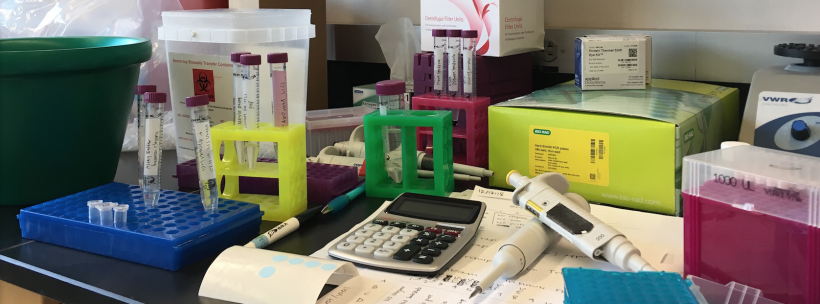20.109(S19):Etoposide treat cells for RNA purification (Day2)
Contents
Introduction
In this module, you will assess gene expression using two methods: quantitative PCR (qPCR) and RNA-seq. For timing reasons you will not be able to prepare and submit your treated samples for RNA-seq. Instead you will use RNA-seq data generated by the teaching faculty. You will, however, complete the same procedure used by the teaching faculty to prepare the RNA samples and then use your samples in a qPCR experiment to confirm the RNA-seq results.
To begin your assay, you will first induce DNA damage by incubating your cells with etoposide. Etoposide is a chemotherapy drug that generates DNA strand breaks by forming a ternary complex with DNA and topoisomerase II. This prevents religation of the DNA strands after unwinding. This effects cancer cells more than non-cancerous cells because cancer cells divide much faster. We will use etoposide to damage the DNA then examine the differences in gene expression of DLD-1 compared to BRCA2-/- cells.
To check that DNA damage was induced by the etoposide treatment, you will measure gene expression of a DNA cell cycle checkpoint factor using quantitative PCR (qPCR). In qPCR, the amount of a specific transcript can be measured. The presence of checkpoint factors in an indication of DNA damage in that the cell cycle is halted when excessive damage is incurred by a cell. For your experiments, the results of p21 expression levels will serve as a control that DNA damage was indeed induced following etoposide treatment. In addition, the qPCR results will be compared to the expression levels measured via RNA-seq.
Protocols
Part 1: Induce DNA damage
In this exercise, you will induce DNA damage in cells that were seeded by the teaching faculty (using the cells you seeded during the previous laboratory session). Next class you will purify RNA from your cells for quantitative PCR analysis. Control, no treatment flasks will be taken care of by instructors.
- Prepare your working space within the tissue culture hood.
- Calculate the volume of etoposide stock needed for DNA damage induction.
- Obtain an aliquot of pre-warmed media from the 37 °C water bath.
- Transfer 10 mL of the media into a 15 mL conical tube.
- Determine the volume of etoposide stock (100 mM) you need to add to the media for a final concentration of 100 μM in the 10 mL aliquot.
- Prepare your media +etoposide.
- Retrieve two T75 flasks (one DLD-1 culture and one BRCA2-/- culture) from the 37 °C incubator and visually inspect your cells with a microscope.
- Record your observations concerning media color, confluency, etc. in your laboratory notebook.
- Move your flasks into the tissue culture hood.
- Aspirate the spent media from each flask.
- Be careful not to cross-contaminant between flasks with different cell lines!
- Add 5 mL of PBS to each flask and rock the plate gently to wash the cells.
- Aspirate the PBS from each flask.
- Again, be careful not to cross-contaminate.
- Add 5 mL of the media containing etoposide that you prepared in Step #2 to the flasks.
- Carefully move the 'etoposide treated' flasks to the 37 °C incubator for 60 min.
- Assist your partner if they are still working. When you are both done, return to the main laboratory space.
- Return to the tissue culture space and retrieve your flasks from the 37 °C incubator.
- Aspirate the media containing etoposide from each flask.
- Be mindful of cross-contamination.
- Add 10 mL of fresh media to each flask.
- Label the flasks containing the DLD-1 and one BRCA2-/- cultures that were treated with etoposide with '+etop' to denote that the cells were treated with only etoposide.
- Move these flasks to the 37 °C incubator.
- Assist your laboratory partner, if necessary, then clean the hood and return the main laboratory space.
Part 2: Discuss research paper
When not in the tissue culture room, you will discuss the research paper by Dietlein et al. (linked here) with the teaching faculty. In their research, the authors completed a screen to examine 1319 cancer-associated genes from 67 cell lines to identify cancer-cell specific mutations that are associated with DNA-PKcs dependence or addiction. Refer to the M2 overview for more information on addiction in cancer cells.
Our paper discussion will assist you in writing a cohesive story that clearly reports the data and provides strong support for the conclusions made about the data.
During the paper discussion, everyone is expected to participate - either by volunteering or by being called upon!
Introduction
Remember the key components of an introduction:
- What is the big picture?
- Is the importance of this research clear?
- Are you provided with the information you need to understand the research?
- Do the authors include a preview of the key results?
Results
Carefully examine the figures. First, read the captions and use the information to 'interpret' the data presented within the image. Second, read the text within the results section that describes the figure.
- Do you agree with the conclusion(s) reached by the authors?
- What controls are included and are they appropriate for the experiment performed?
- Are you convinced that the data are accurate and/or representative?
Discussion
Consider the following components of a discussion:
- Are the results summarized?
- Did the authors 'tie' the data together into a cohesive and well-interpreted story?
- Do the authors overreach when interpreting the data?
- Are the data linked back to the big picture from the introduction?
Reagents
- etoposide, stock = 100 mM (Sigma-Aldrich)
Next day: Purify RNA and practice RNA-seq data analysis methods
Previous day: Practice tissue culture techniques and prepare cells for RNA purification
